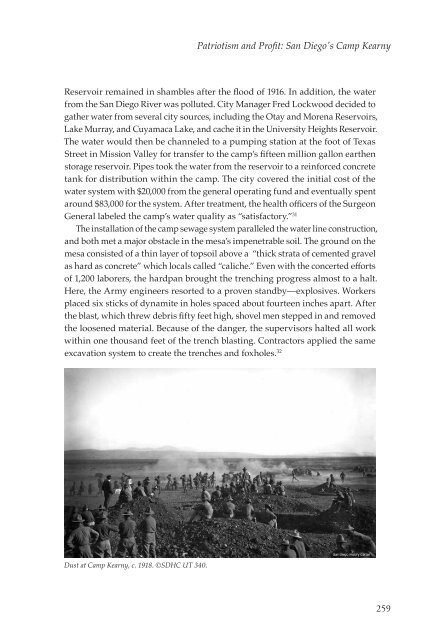Complete Issue Online - San Diego History Center
Complete Issue Online - San Diego History Center
Complete Issue Online - San Diego History Center
Create successful ePaper yourself
Turn your PDF publications into a flip-book with our unique Google optimized e-Paper software.
Patriotism and Profit: <strong>San</strong> <strong>Diego</strong>'s Camp Kearny<br />
Reservoir remained in shambles after the flood of 1916. In addition, the water<br />
from the <strong>San</strong> <strong>Diego</strong> River was polluted. City Manager Fred Lockwood decided to<br />
gather water from several city sources, including the Otay and Morena Reservoirs,<br />
Lake Murray, and Cuyamaca Lake, and cache it in the University Heights Reservoir.<br />
The water would then be channeled to a pumping station at the foot of Texas<br />
Street in Mission Valley for transfer to the camp’s fifteen million gallon earthen<br />
storage reservoir. Pipes took the water from the reservoir to a reinforced concrete<br />
tank for distribution within the camp. The city covered the initial cost of the<br />
water system with $20,000 from the general operating fund and eventually spent<br />
around $83,000 for the system. After treatment, the health officers of the Surgeon<br />
General labeled the camp’s water quality as “satisfactory.” 31<br />
The installation of the camp sewage system paralleled the water line construction,<br />
and both met a major obstacle in the mesa’s impenetrable soil. The ground on the<br />
mesa consisted of a thin layer of topsoil above a “thick strata of cemented gravel<br />
as hard as concrete” which locals called “caliche.” Even with the concerted efforts<br />
of 1,200 laborers, the hardpan brought the trenching progress almost to a halt.<br />
Here, the Army engineers resorted to a proven standby—explosives. Workers<br />
placed six sticks of dynamite in holes spaced about fourteen inches apart. After<br />
the blast, which threw debris fifty feet high, shovel men stepped in and removed<br />
the loosened material. Because of the danger, the supervisors halted all work<br />
within one thousand feet of the trench blasting. Contractors applied the same<br />
excavation system to create the trenches and foxholes. 32<br />
Dust at Camp Kearny, c. 1918. ©SDHC UT 340.<br />
259







![[PDF] The Journal of San Diego History Vol 52: Nos 1 & 2](https://img.yumpu.com/25984149/1/172x260/pdf-the-journal-of-san-diego-history-vol-52-nos-1-2.jpg?quality=85)

![[PDF] The Journal of San Diego History - San Diego History Center](https://img.yumpu.com/25984131/1/172x260/pdf-the-journal-of-san-diego-history-san-diego-history-center.jpg?quality=85)







